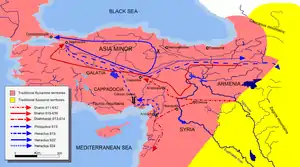624
Year 624 (DCXXIV) was a leap year starting on Sunday (link will display the full calendar) of the Julian calendar. The denomination 624 for this year has been used since the early medieval period, when the Anno Domini calendar era became the prevalent method in Europe for naming years.
| Millennium: | 1st millennium |
|---|---|
| Centuries: | |
| Decades: | |
| Years: |
| 624 by topic |
|---|
| Leaders |
|
| Categories |
|
| Gregorian calendar | 624 DCXXIV |
| Ab urbe condita | 1377 |
| Armenian calendar | 73 ԹՎ ՀԳ |
| Assyrian calendar | 5374 |
| Balinese saka calendar | 545–546 |
| Bengali calendar | 31 |
| Berber calendar | 1574 |
| Buddhist calendar | 1168 |
| Burmese calendar | −14 |
| Byzantine calendar | 6132–6133 |
| Chinese calendar | 癸未年 (Water Goat) 3320 or 3260 — to — 甲申年 (Wood Monkey) 3321 or 3261 |
| Coptic calendar | 340–341 |
| Discordian calendar | 1790 |
| Ethiopian calendar | 616–617 |
| Hebrew calendar | 4384–4385 |
| Hindu calendars | |
| - Vikram Samvat | 680–681 |
| - Shaka Samvat | 545–546 |
| - Kali Yuga | 3724–3725 |
| Holocene calendar | 10624 |
| Iranian calendar | 2–3 |
| Islamic calendar | 2–3 |
| Japanese calendar | N/A |
| Javanese calendar | 514–515 |
| Julian calendar | 624 DCXXIV |
| Korean calendar | 2957 |
| Minguo calendar | 1288 before ROC 民前1288年 |
| Nanakshahi calendar | −844 |
| Seleucid era | 935/936 AG |
| Thai solar calendar | 1166–1167 |
| Tibetan calendar | 阴水羊年 (female Water-Goat) 750 or 369 or −403 — to — 阳木猴年 (male Wood-Monkey) 751 or 370 or −402 |
Events
Byzantine Empire
- Byzantine–Sasanian War: Emperor Heraclius advances with an expeditionary force (40,000 men) along the Araxes River, destroying the fortress city of Dvin, capital of Armenia, and Nakhchivan (modern Azerbaijan). At Ganzak, Heraclius defeats the Persian army and destroys the famous fire temple at Takht-e Soleymān, an important Zoroastrian shrine.[1] He winters his army in Caucasian Albania to gather forces for the next year.[2]
- Winter – King Khosrow II withdraws most of his troops from Chalcedon (Anatolia); he assembles three armies to trap and destroy Heraclius' forces.[3] The Persians go into winter quarters nearby, but Heraclius attacks them at Tigranakert (Western Armenia), routing the forces of the generals Shahin Vahmanzadegan and Shahraplakan. The Byzantines destroy their baggage train.
Europe
- The Visigoths under King Suintila recapture the Byzantine territories of Spania (Andalusia), after 70 years of occupation. Only the Balearic Islands stay a part of the Byzantine Empire.
Britain
- Eorpwald succeeds his father Rædwald, as king (bretwalda) of the independent Kingdom of East Anglia (approximate date).
Arabia
- March 13 – Battle of Badr: Muhammad and some 300 of his followers from Medina surprise a reinforced Meccan caravan at Badr (modern-day Saudi Arabia) returning from Syria, and defeat about 1,000 Quraysh from Mecca. After having heard that clan leader Abu Sufyan is escorting a rich trade caravan, Muhammad has the wells along its route (southwest of Medina) filled with sand in order to lure him into battle.
Asia
- The Yiwen Leiju encyclopedia is completed during the Tang dynasty, by the Chinese calligrapher Ouyang Xun.
Religion
- Justus becomes Archbishop of Canterbury,[4] receiving his pallium — symbol of the jurisdiction entrusted to archbishops. He oversees the dispatch of missionaries to Northumbria (northern England).
Births
- February 17 – Wu Zetian, Empress of the Zhou dynasty (d. 705)
- May – Abd Allah ibn al-Zubayr, Arab sahabi (d. 692)
- Hasan ibn Ali, second Shia Imam and grandson of Prophet Muhammad (d. 670)
- Yazdegerd III, king of the Persian Empire (d. 651)
- Approximate date – Adomnán, Irish abbot and hagiographer (d. 704)[5]
Deaths
- March 17 – Amr ibn Hishām, Arab polytheist
- April 24 – Mellitus, Archbishop of Canterbury[6]
- Abū Lahab, uncle of Muhammad (approximate date)
- Du Fuwei, rebel leader during the Sui dynasty (b. 598)
- Fu Gongshi, rebel leader during the Sui dynasty
- Gao Kaidao, rebel leader during the Sui dynasty
- Rædwald, king of East Anglia (approximate date)
- Ruqayyah, daughter of Muhammad (approximate date)
- Umayyah ibn Khalaf, clan leader of the Quraysh
- Utbah ibn Rabi'ah, clan leader of the Quraysh
References
- Kaegi 2003, p. 127.
- Kaegi 2003, p. 128.
- Kaegi 2003, p. 129.
- Fryde, E.B. (1996), "Handbook of British Chronology" (Third revised ed.). Cambridge, UK: Cambridge University Press, p. 213. ISBN 0-521-56350-X
- Cooper, J. C. (2013). Dictionary of Christianity. Abingdon, Oxon. p. 2. ISBN 9781315074047.
- Bellenger, Dominic Aidan; Fletcher, Stella (February 17, 2005). The Mitre and the Crown: A History of the Archbishops of Canterbury. History Press. p. 149. ISBN 978-0-7524-9495-1.
Sources
- Kaegi, Walter E. (2003). Heraclius: emperor of Byzantium. Cambridge University Press. ISBN 0-521-81459-6.
This article is issued from Wikipedia. The text is licensed under Creative Commons - Attribution - Sharealike. Additional terms may apply for the media files.
